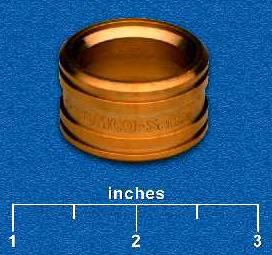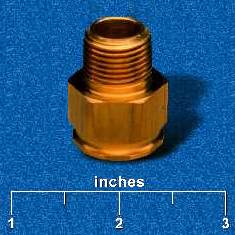ACTUATING SLEEVE
| APPLICATION | Pneumatic Power |
| SPECIAL FEATURES | High Turnings Ratio, |
| PART WEIGHT | 0.083 lb. (Brass) |
| BRASS RAW MATERIAL PREMIUM | 17% (Including Turnings Allowance) |
| CYCLE TIME (BRASS) | 4.75 sec (606 pieces per hour |
| CYCLE TIME (STEEL) | 8.4 sec (300 pieces per hour |
| PRODUCTIVITY GAIN |
102% |
| NET COST SAVINGS |
23% = $58.76 per 1000 |
| NET COST SAVINGS |
26% = $71.05 per 1000 |
PRODUCTIVITY AND PLATING SAVINGS SWITCH PART FROM STEEL TO BRASS
 This actuating sleeve must be strong and corrosion resistant to work in industrial environments; it's a fairly typical screw machine product. The sleeve is now made from Free-Cutting Brass, Copper Alloy 360, (UNS C36000); it used to be made from 12L14 leaded steel, but it costs about 26% less in brass than it does in steel.
This actuating sleeve must be strong and corrosion resistant to work in industrial environments; it's a fairly typical screw machine product. The sleeve is now made from Free-Cutting Brass, Copper Alloy 360, (UNS C36000); it used to be made from 12L14 leaded steel, but it costs about 26% less in brass than it does in steel.
Many designers think that because brass costs more than steel, machined brass parts must cost more too. That's not true for typical screw machine jobs. Only brass rod's off-the-shelf material cost is significantly higher; this actuating sleeve produces more than four times as much turnings weight as it does product and after discounting for the turnings' high value, the net material cost difference is only 17%.
HIGH MACHINABILITY MEANS LOWER PRODUCTION COSTS
When you buy machine parts you are paying for machine time. The faster the cut, the lower the cost, and free cutting brass machines faster than leaded steel. The productivity gained by switching from steel to brass for this actuating sleeve was a very significant 102%. How much can you save on your next screw machine part?
ELIMINATE PLATING COSTS
Steel rusts, brass tarnishes; an important difference. Exposed steel screw machine parts have to be zinc/ chromate plated. Brass parts are ready to use without protective platings. The savings are between 11 and 16 cents per pound of product. If your part has deep holes, threads, or sharp corners, it can be difficult to insure uniform plating on all surfaces. Make the part in brass in you eliminate that concern. The natural corrosion resistance of brass uniformly protects the entire surface. If decorative plating is desired, brass plates more easily and is better looking than plated steel.
BRASS HAS GOOD MECHANICAL PROPERTIES
The strength of half-hard Free-Cutting Brass is in the same range as 12L14 steel. Published nominal values for these materials are:
| MATERIAL | TENSILE PROPERTIES | |
|---|---|---|
| YIELD STRENGTH | ULTIMATE STRENGTH | |
| C36000 | 45 ksi | 58 ksi |
| Hot Rolled 12L14 | 34 ksi | 57 ksi |
| Cold Drawn 12L14 | 60 ksi | 78 ksi |
The tensile strength of half-hard brass rod, the most common temper, is about 75% that of cold finished 12L14 steel. Therefore, even if your design is based on the strength of steel, it may be possible to specify brass with no loss of performance and a considerable cost savings.
AIR BRAKE HOSE FITTING
| APPLICATION | Automotive/Truck |
| SPECIAL FEATURES | Meets DOT Safety Requirements |
| PART WEIGHT | 0.091 lb. (Brass) |
| BRASS RAW MATERIAL PREMIUM | 36% (Including Turnings Allowance) |
| CYCLE TIME (BRASS) | 5.6 sec (515 pieces per hour @ 80% Efficiency) |
| CYCLE TIME (STEEL) | 9.1 sec (277 pieces per hour @ 70% Efficiency) |
| PRODUCTIVITY GAIN |
86% |
| NET COST SAVINGS |
19% = $46.00 per 1000 |
| NET COST SAVINGS (BRASS VS.PLATED STEEL)* | 23% = $59.47 per 1000 |
STRENGTH PLUS CORROSION RESISTANCE EQUALS SAFETY
 This air brake hose fitting, a typical screw machine part, has to be strong and corrosion resistant to meet DOT (Department of Transportation) safety requirements. Originally made from 12L14 leaded steel and zinc/chromate plated to retard corrosion from water and road salts, the fitting is now produced in Free-Cutting Brass, Copper Alloy 360 (UNS C36000). It's just as strong as steel, it doesn't have to be plated . . . and it costs 23% less.
This air brake hose fitting, a typical screw machine part, has to be strong and corrosion resistant to meet DOT (Department of Transportation) safety requirements. Originally made from 12L14 leaded steel and zinc/chromate plated to retard corrosion from water and road salts, the fitting is now produced in Free-Cutting Brass, Copper Alloy 360 (UNS C36000). It's just as strong as steel, it doesn't have to be plated . . . and it costs 23% less.
The strength of half-hard Free-Cutting Brass is in the same range as 12L14 steel. Published nominal values for these materials are:
| TENSILE PROPERTIES | ||
|---|---|---|
| MATERIAL | YIELD STRENGTH | ULTIMATE STRENGTH |
| C36000 | 45 ksi | 58 ksi |
| Hot Rolled 12L14 | 34 ksi | 57 ksi |
| Cold Drawn 12L14 | 60 ksi | 78 ksi |
The tensile strength of half-hard brass rod, the most common temper, is about 75% that of cold finished 12L14 steel. Therefore, even if your design is based on the strength of steel, it may be possible to specify brass with no loss of performance and a considerable cost savings.
BRASS PARTS COST LESS THAN STEEL
Many designers think that because brass costs more than steel, machined brass parts must cost more too. That's not true for typical screw machine jobs. Only brass rod's off-the-shelf material cost is significantly higher; this air brake hose fitting produces more than three times as much turnings weight as it does product and after discounting for the turnings' high value, the net material cost difference is only 36%.
HIGH MACHINABILITY MEANS LOWER PRODUCTION COSTS
When you buy machine parts you are paying for machine time. The faster the cut, the lower the cost, and free cutting brass machines faster than leaded steel. The productivity gained by switching from steel to brass for this actuating sleeve was a very significant 86%. How much can you save on your next screw machine part?
ELIMINATE PLATING COSTS
Steel rusts, brass tarnishes; an important difference. Exposed steel screw machine parts have to be zinc/ chromate plated. Brass parts are ready to use without protective platings. The savings are between 11 and 16 cents per pound of product. If your part has deep holes, threads, or sharp corners, it can be difficult to insure uniform plating on all surfaces. Make the part in brass in you eliminate that concern. The natural corrosion resistance of brass uniformly protects the entire surface. If decorative plating is desired, brass plates more easily and is better looking than plated steel.
